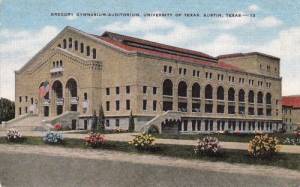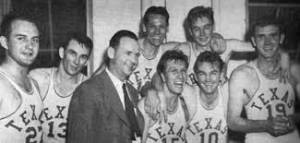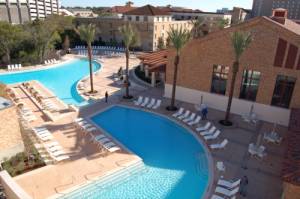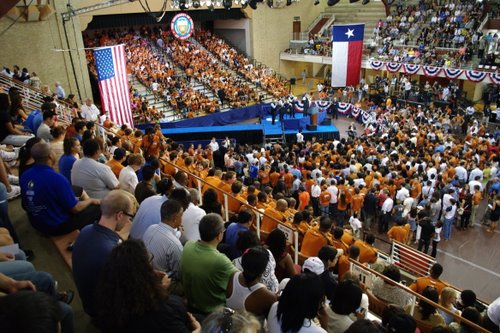In one respect, I am unqualified to write this piece since I am 7,000 miles from the scene and have been living the expat life for almost a decade. Nevertheless, I am a graduate of the University of Texas, wrote  three books on Longhorn sports history and lived in Austin for more than 30 years, on or near the campus. In the process of doing those books, I spent hours and hours poring over back issues of the Daily Texan (student newspaper), Cactus (student yearbook), Alcalde (alumni magazine) and the Austin American-Statesman. I interviewed ex-players, coaches, athletic directors and sports writers. I also edited Margaret Berry’s Brick by Golden Brick / A History of Campus Buildings at the University of Texas. In this process, I was able to get some feel for how students of my alma mater lived and thought in the 1920s, the 1930s, the 1940s and so forth.
three books on Longhorn sports history and lived in Austin for more than 30 years, on or near the campus. In the process of doing those books, I spent hours and hours poring over back issues of the Daily Texan (student newspaper), Cactus (student yearbook), Alcalde (alumni magazine) and the Austin American-Statesman. I interviewed ex-players, coaches, athletic directors and sports writers. I also edited Margaret Berry’s Brick by Golden Brick / A History of Campus Buildings at the University of Texas. In this process, I was able to get some feel for how students of my alma mater lived and thought in the 1920s, the 1930s, the 1940s and so forth.
A splendid home for Texas hoops
Thomas W. Gregory, part of UT’s first graduating class (1884), started urging the construction of a substantial auditorium-gymnasium in 1903. As attorney general for five years in the Woodrow Wilson administration, Gregory had helped craft the Espionage and Sedition Acts, and urged their vigorous prosecution, curtailing freedom of speech and the press. That, however, is not our issue. Gregory, a former member of the Board of Regents, had clout at the university and used it. Gregory Gymnasium opened on April 12, 1930, costing $500,000. Memorial Stadium, a couple of blocks down 21st Street, had been erected six years earlier and has always meant more. UT’s stadium is the holy of holies, as it were, and who am I to question the primacy of football in the state of Texas? Still, basketball deserved a home more suitable than the ramshackle Men’s Gym where the team had played for the past decade. To be precise, it had burned in 1928, forcing the Horns to hold games at the Texas School for the Deaf and Austin High School in 1929 and 1930, respectively.
Gregory Gym, as we will see, has always been an important building on the Forty Acres. But by the early 1990s, it was thoroughly outdated. Furthermore, the Rec Sports Center had been built on San Jacinto Boulevard, and most students looking for exercise went there instead. Hard-eyed administrators, aware that Gregory Gym occupied valuable real estate in the middle of campus, considered razing it. That idea horrified alumni since it had been the scene of many decades of history, athletic and otherwise. The alums raised a fuss, and anyway it was quite solidly built with a classic look; a two-year, $27 million renovation was begun that gave the old arena a second wind.
In the early days of Gregory Gym, it was not unusual for football players to suit up for the hardcourt game after the season was over. I can think of no better example than Jack Gray, a varsity starter in both sports from 1933 to 1935. His game featured a one-handed push shot that was a precursor to the jumper. Gray had scarcely graduated when he was put in charge of UT hoops. He coached for 10 years, bisected by World War II service in which he won five battle stars as a lieutenant commander in the U.S. Navy. His 1947 team, led by Slater Martin, came within a whisker of winning the national championship.
Other notable Longhorns who played at Gregory Gym were Bobby Moers, Denton Cooley (later a world-famous heart surgeon), Raymond Downs (26 points per game in 1956, still a school record), high-flying Jay Arnette and Wayne Doyal. Most of all, I remember the guys who were there during my  undergraduate days: Harry Larrabee, B.G. Brosterhous, Tyrone Johnson, Eric Groscurth, Jimmy Blacklock, Scooter Lenox (his older brother, Bennie, coach of the freshman team, kindly told me I was welcome to try out) and Larry Robinson. Coach Leon Black’s teams had a pleasing ethnic balance—half European-American and half black. They won the Southwest Conference crown in 1972 and again in 1974, you know.
undergraduate days: Harry Larrabee, B.G. Brosterhous, Tyrone Johnson, Eric Groscurth, Jimmy Blacklock, Scooter Lenox (his older brother, Bennie, coach of the freshman team, kindly told me I was welcome to try out) and Larry Robinson. Coach Leon Black’s teams had a pleasing ethnic balance—half European-American and half black. They won the Southwest Conference crown in 1972 and again in 1974, you know.
Cultural codes
But I also vividly remember some of the Longhorns’ opponents. One was Richard Little of Texas Tech, a guard with such confidence that he welcomed boos. He would thump his chest, tug his jersey and defy the fans to do anything about it. There was Mario Brown, the first black player at Texas A&M. He wore a smirk on his face as he dribbled down court. Martin Terry and Dean Tolson of Arkansas combined on some breathtaking alley-oops. And then there were Ruben Triplett and Sammy Hervey of SMU. You talk about making a dramatic entrance. It was February 1972, and I was there with my date, Sarah Marie Smith. The women’s prelim game was going on when these two tall gentlemen entered from the west doors of Gregory Gym. Attired in garish Super Fly shoes, pants, shirts and hats, and sporting mighty Afros, Triplett and Hervey strolled—as slowly as they pleased—down the side of the court and finally into the visitors’ dressing room. You might say they had all the cultural codes.
Gregory Gym also hosted the state high school basketball championships for 46 years. It was exciting when the campus was invaded by young teams and their fans from Houston, Dallas, Fort Worth, San Antonio, Corpus Christi and small towns like Nacogdoches, Brownfield, Snook and White Oak.
There were speeches (I witnessed Ralph Nader, Dick Gregory and David Halberstam), graduation ceremonies, gubernatorial inauguration balls, chaotic registration for classes at UT, dances, performing arts presentations (T.S. Eliot read poetry, Louie Armstrong played his trumpet, and Frank Sinatra sang, not to mention a 1974 double bill of Canned Heat and Dan Hicks & His Hot Licks), boxing matches and more. Yes, much more. It was the hub of an intramural program that was the envy of many other universities. You had your choice of softball, table tennis, track, touch football, wrestling, swimming, fencing, basketball, badminton and seemingly a hundred other sports. There was an office in Gregory Gym that arranged outings to Big Bend, Palo Duro Canyon, Enchanted Rock, Pedernales Falls and so on. An annex had been built on the south side of the gym in 1963 with five basketball courts. I played in numerous pickup games there and in the main gym during my student days and later. I also have fond memories of playing handball and racquetball in some of the old courts.
In the late 1980s, I sometimes I went to Gregory Gym when it was mostly empty and sat on the top row. I tried, however unsuccessfully, to soak up the history and ambience. I worried, too, about its future  before the university announced plans for its renovation. After completion of that project, I returned to a sparkling “new” Gregory Gym. I will not try to list all the changes, but it had been brought in line with the demands of a new generation of students. Its main tenant is the UT women’s volleyball team, both basketball teams having left in 1977 for the Erwin Center half a mile south. That $34 million facility had room for 16,000 fans—as opposed to 7,000 max (if the fire marshal was not being picky) at Gregory Gym. The Erwin Center, though, is sterile compared to its predecessor. From the start, it has been hard to get students to attend games there. An older and more sedate crowd is the norm, not to mention the fact that they are physically separated from the court and athletes. Gregory Gym, where the first row stood a couple of feet from the action, was nothing if not intimate.
before the university announced plans for its renovation. After completion of that project, I returned to a sparkling “new” Gregory Gym. I will not try to list all the changes, but it had been brought in line with the demands of a new generation of students. Its main tenant is the UT women’s volleyball team, both basketball teams having left in 1977 for the Erwin Center half a mile south. That $34 million facility had room for 16,000 fans—as opposed to 7,000 max (if the fire marshal was not being picky) at Gregory Gym. The Erwin Center, though, is sterile compared to its predecessor. From the start, it has been hard to get students to attend games there. An older and more sedate crowd is the norm, not to mention the fact that they are physically separated from the court and athletes. Gregory Gym, where the first row stood a couple of feet from the action, was nothing if not intimate.
Fewer seats, more advertising
The above-mentioned Texas women’s volleyball team won national titles in 1988 and 2012, and was runner-up in 1995, 2009 and 2015. I have a couple of comments about the look of Gregory Gym (today’s seating capacity: 4,000) as the home arena for these superb female athletes. First, the place is chock full of advertising. A photo I saw recently showed signage for Taco Shack, Dunkin’ Donuts, Southwest Airlines and Mike’s Print Shop. There was a time when UT had a hard-and-fast rule against such  mercantilism. I can live with that. However, a bigger problem is the court which is outlined in orange and black. For well over a century, the school colors have been orange and white, and I am miffed when I see any alteration thereof. Do I sound hopelessly behind the times?
mercantilism. I can live with that. However, a bigger problem is the court which is outlined in orange and black. For well over a century, the school colors have been orange and white, and I am miffed when I see any alteration thereof. Do I sound hopelessly behind the times?
It is interesting to note that the Erwin Center will soon be razed to make way for the Dell Medical School (the new hoops facility will probably be just south of the Myers Soccer/Track Stadium), while stately Gregory Gymnasium endures at the intersection of 21st and Speedway. For almost 90 years now, it has been a major part of University of Texas student life.


Add Comment